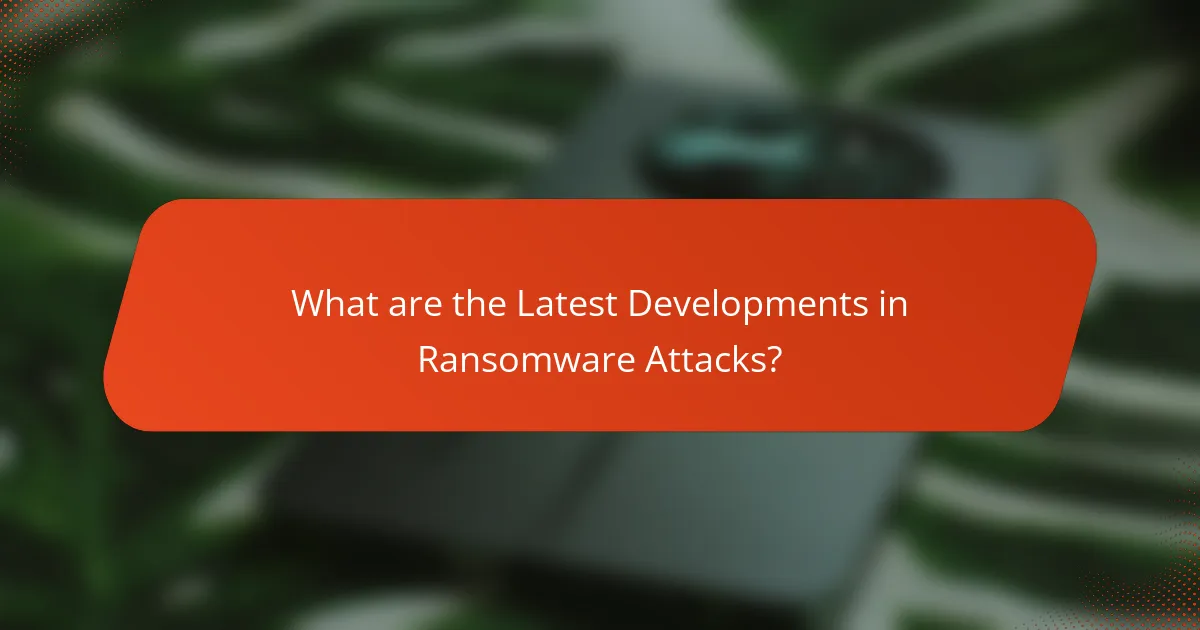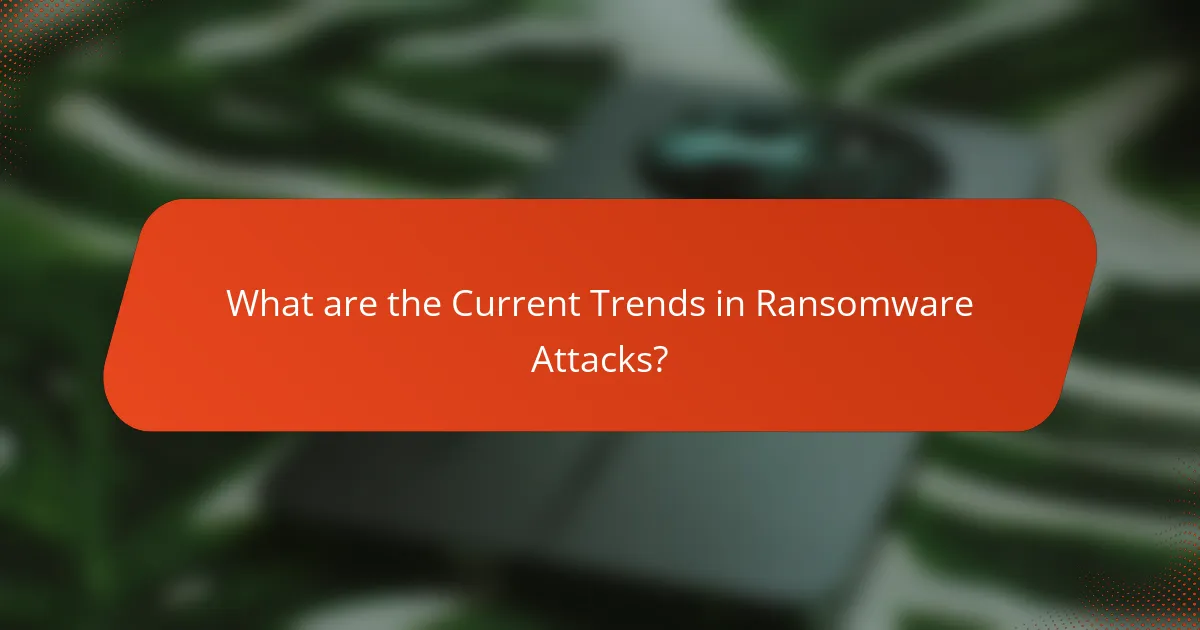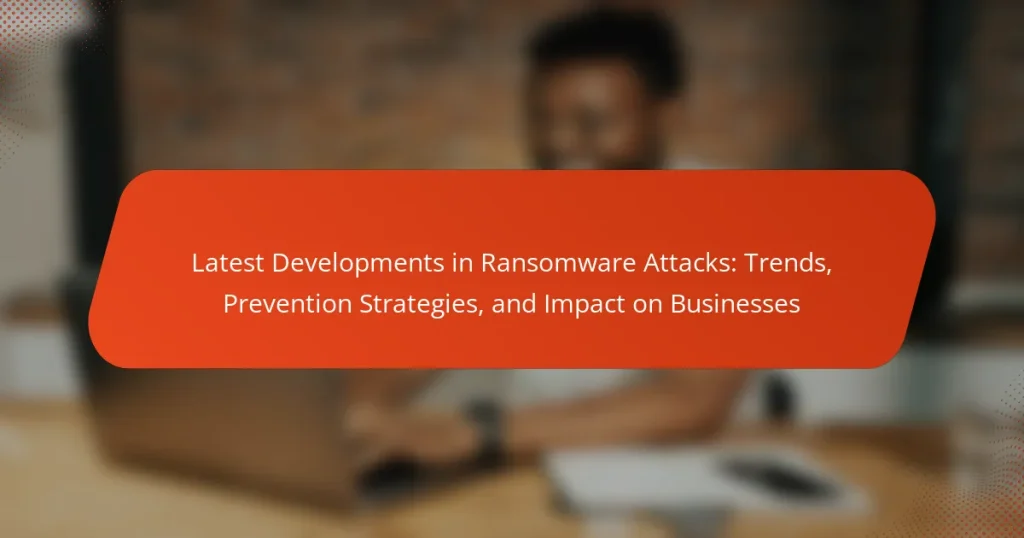Ransomware attacks have increasingly targeted critical infrastructure and the healthcare sector, with significant incidents such as the Colonial Pipeline and JBS meat processing plant attacks highlighting their impact. Current trends include the adoption of double extortion tactics, where attackers not only encrypt data but also threaten to release sensitive information unless ransoms are paid. The rise of ransomware-as-a-service (RaaS) models has enabled less technically skilled individuals to launch sophisticated attacks, broadening the threat landscape. Projections indicate that ransomware damages could reach $265 billion annually by 2031, emphasizing the financial repercussions for businesses. To mitigate these risks, organizations can implement various prevention strategies, including software updates, employee training, and strong security measures.

What are the Latest Developments in Ransomware Attacks?
Recent ransomware attacks have increasingly targeted critical infrastructure and healthcare sectors. Notable incidents include the Colonial Pipeline attack in May 2021, which disrupted fuel supplies across the East Coast. Additionally, the attack on the JBS meat processing plant affected food supply chains.
Ransomware groups are now employing double extortion tactics. They not only encrypt data but also threaten to release sensitive information if ransoms are not paid. This trend has heightened the pressure on victims to comply with demands.
Moreover, ransomware-as-a-service models have emerged. These allow less technically skilled criminals to launch attacks using sophisticated tools provided by experienced hackers. This has expanded the pool of potential attackers significantly.
According to a report by Cybersecurity Ventures, ransomware damages are projected to reach $265 billion annually by 2031. This underscores the escalating financial impact on businesses.
Finally, governments are taking action. The U.S. Department of Justice has established a ransomware task force to combat these threats. These developments highlight the evolving landscape of ransomware and the need for enhanced cybersecurity measures.
How have ransomware attacks evolved in recent years?
Ransomware attacks have evolved significantly in recent years. They have become more sophisticated and targeted. Attackers now utilize advanced encryption techniques. This makes it harder for victims to recover data without paying a ransom. Additionally, ransomware groups have adopted a double extortion model. They not only encrypt data but also threaten to leak sensitive information. According to a report by Cybersecurity Ventures, ransomware damages are projected to reach $20 billion by 2021. This increase in financial impact highlights the growing threat. Furthermore, ransomware attacks now target critical infrastructure sectors. Hospitals and energy companies have become prime targets. These changes indicate a shift in the motivations and tactics of cybercriminals.
What are the new techniques used by cybercriminals?
Cybercriminals are increasingly using techniques such as ransomware-as-a-service, which allows attackers to rent ransomware tools. This model lowers the barrier for entry into cybercrime. Phishing attacks have evolved with more sophisticated social engineering tactics. Attackers now create highly personalized messages to trick individuals into revealing sensitive information. Additionally, they exploit vulnerabilities in software through zero-day attacks. These attacks target unpatched systems, making them particularly dangerous. Multi-factor authentication bypass methods are also on the rise. Cybercriminals use techniques like SIM swapping to gain access to accounts. Finally, they leverage cryptocurrency to facilitate anonymous transactions. This anonymity complicates law enforcement efforts to track illicit activities.
How has the frequency of attacks changed?
The frequency of ransomware attacks has significantly increased in recent years. Reports indicate a rise of over 300% in attacks from 2020 to 2021. In 2022, the trend continued, with an estimated 70% increase in incidents compared to the previous year. The rise is attributed to more sophisticated attack methods and increased targeting of critical infrastructure. According to cybersecurity firms, businesses are now attacked every 11 seconds on average. This change highlights the urgent need for enhanced cybersecurity measures across all sectors.
What types of businesses are most affected by ransomware?
Businesses in healthcare, finance, and education are most affected by ransomware. These sectors often hold sensitive data and face regulatory pressures. Healthcare organizations reported a 50% increase in ransomware attacks in 2021. Financial institutions are prime targets due to their ability to pay ransoms. Educational institutions experienced a surge in attacks during the COVID-19 pandemic, with over 1,000 incidents reported in 2020. Additionally, small to medium-sized enterprises are increasingly targeted as they may lack robust cybersecurity measures.
Which industries are experiencing the highest rates of attacks?
The industries experiencing the highest rates of attacks include healthcare, finance, and manufacturing. Healthcare organizations face significant threats due to sensitive patient data. According to a report by Cybersecurity Ventures, healthcare is the most targeted sector, with a 55% increase in ransomware attacks in 2021. The finance sector is also heavily targeted, as cybercriminals seek access to financial information and funds. Manufacturing industries face disruptions from attacks that can halt production and supply chains. Reports indicate that ransomware attacks in manufacturing rose by 50% in 2021, highlighting the urgency for improved security measures.
What is the impact of attacks on small vs. large businesses?
Attacks on small businesses typically result in more severe consequences compared to large businesses. Small businesses often lack robust cybersecurity measures. This makes them more vulnerable to ransomware attacks. According to a 2021 report by the Cybersecurity & Infrastructure Security Agency, 60% of small businesses close within six months of a cyberattack. In contrast, large businesses generally have more resources to recover. They can invest in advanced security systems and incident response teams. However, large businesses face larger financial losses per incident. The average cost of a data breach for large companies can reach millions, as reported by IBM’s 2023 Cost of a Data Breach Report. Therefore, while small businesses suffer higher relative impacts, large businesses endure greater absolute financial damages from attacks.

What are the Current Trends in Ransomware Attacks?
Current trends in ransomware attacks include the rise of double extortion tactics and targeting of critical infrastructure. Attackers increasingly steal data before encryption, threatening exposure if ransoms are not paid. Ransomware-as-a-Service (RaaS) models have gained popularity, allowing less technical criminals to execute attacks. Additionally, there is a growing focus on healthcare and governmental sectors, reflecting their vulnerability and the potential for high payouts. According to a report by Cybersecurity Ventures, ransomware damages are projected to reach $265 billion annually by 2031. Enhanced collaboration among cybercriminals is also evident, leading to more sophisticated attacks.
How do ransomware attacks target specific vulnerabilities?
Ransomware attacks target specific vulnerabilities by exploiting weaknesses in software, networks, and human behavior. Attackers often use automated tools to scan for systems with outdated software. These systems may have unpatched vulnerabilities that can be easily exploited. Phishing emails are another common method used to trick users into revealing credentials. Once access is gained, attackers can deploy ransomware to encrypt files. According to a report by Cybersecurity Ventures, ransomware attacks are projected to occur every 11 seconds by 2021. This highlights the urgency for organizations to address vulnerabilities proactively. Regular software updates and employee training can significantly reduce the risk of such attacks.
What common vulnerabilities are exploited by attackers?
Common vulnerabilities exploited by attackers include weak passwords, outdated software, and unpatched systems. Weak passwords can be easily guessed or cracked, allowing unauthorized access. Outdated software often contains known security flaws that attackers can exploit. Unpatched systems fail to address vulnerabilities, making them prime targets for attacks. Additionally, phishing attacks exploit human error, tricking users into revealing sensitive information. Misconfigured networks can expose sensitive data, further increasing risk. According to the Verizon Data Breach Investigations Report, 81% of hacking-related breaches leverage stolen or weak passwords. This highlights the critical need for robust security measures.
How does the use of ransomware-as-a-service affect trends?
The use of ransomware-as-a-service (RaaS) significantly increases the prevalence of ransomware attacks. RaaS lowers the entry barrier for cybercriminals, enabling even those with limited technical skills to launch attacks. This trend has led to a surge in the number of attacks targeting businesses of all sizes. According to a report by Cybersecurity Ventures, ransomware attacks are expected to occur every 11 seconds by 2021, highlighting the rapid growth of this threat. Additionally, RaaS creates a marketplace for cybercriminals, fostering collaboration and innovation in attack methods. This has resulted in more sophisticated and varied ransomware strains. The financial impact on businesses has also escalated, with costs related to recovery and ransom payments rising dramatically. Overall, RaaS has transformed the ransomware landscape, making attacks more frequent and damaging.
What role does cryptocurrency play in ransomware attacks?
Cryptocurrency serves as the primary payment method in ransomware attacks. It allows attackers to receive ransom payments anonymously. This anonymity makes it difficult for law enforcement to trace transactions. Cryptocurrencies like Bitcoin are commonly used due to their decentralized nature. In 2021, a report indicated that over 90% of ransomware payments were made in cryptocurrency. This trend highlights the growing reliance on digital currencies in cybercrime. Furthermore, the volatility of cryptocurrencies can increase the ransom amount demanded. Attackers often exploit this to maximize their profits.
How do attackers use cryptocurrency for ransom payments?
Attackers use cryptocurrency for ransom payments to ensure anonymity and facilitate untraceable transactions. They demand payment in cryptocurrencies like Bitcoin, which allows them to evade traditional banking systems. The decentralized nature of cryptocurrencies makes it difficult for law enforcement to track these transactions. Attackers typically provide victims with a cryptocurrency wallet address to which the ransom must be sent. Once the payment is made, they may provide decryption keys or other methods to restore access. According to the 2022 Cybersecurity & Infrastructure Security Agency report, 70% of ransomware payments were made in cryptocurrency. This trend highlights the growing reliance on digital currencies in cybercrime.
What are the implications of cryptocurrency on law enforcement efforts?
Cryptocurrency poses significant challenges for law enforcement efforts. Its decentralized nature complicates tracking illicit transactions. Criminals often use cryptocurrencies to facilitate ransomware attacks, making it difficult to trace funds. Law enforcement agencies struggle with jurisdictional issues due to the global nature of blockchain technology. The anonymity provided by cryptocurrencies can hinder investigations. However, some blockchain analytics tools have emerged to assist in monitoring transactions. These tools can help identify patterns linked to criminal activity. Ultimately, while cryptocurrencies offer advantages for users, they also create obstacles for law enforcement.

What Prevention Strategies Can Businesses Implement?
Businesses can implement various prevention strategies to combat ransomware attacks. Regularly updating software and systems reduces vulnerabilities. Employee training on cybersecurity best practices is essential. Implementing strong password policies enhances security. Regular data backups ensure recovery options are available. Using antivirus and anti-malware solutions provides additional protection. Network segmentation limits the spread of attacks. Multi-factor authentication adds an extra layer of security. These strategies collectively enhance overall cybersecurity resilience against ransomware threats.
How can businesses protect themselves from ransomware attacks?
Businesses can protect themselves from ransomware attacks by implementing robust cybersecurity measures. Regularly updating software and operating systems reduces vulnerabilities. Employing firewalls and antivirus solutions helps to block malicious activities. Businesses should conduct regular backups of critical data to ensure recovery options. Training employees on recognizing phishing attempts is essential for prevention. Implementing multi-factor authentication adds an extra layer of security. Monitoring network traffic can identify unusual activities early. According to Cybersecurity Ventures, ransomware damages are expected to reach $265 billion by 2031, highlighting the importance of these protective measures.
What are the best practices for cybersecurity hygiene?
Best practices for cybersecurity hygiene include regularly updating software and systems. This helps close vulnerabilities that attackers exploit. Implementing strong, unique passwords for accounts is crucial. Multi-factor authentication adds an extra layer of security. Regularly backing up data protects against data loss from ransomware attacks. Users should be trained to recognize phishing attempts and suspicious links. Firewalls and antivirus software should be active and updated. Conducting regular security audits identifies potential weaknesses in systems. These practices collectively enhance overall cybersecurity posture and reduce risks.
How important is employee training in prevention efforts?
Employee training is crucial in prevention efforts against ransomware attacks. It equips employees with the knowledge to recognize threats. Training helps employees understand phishing tactics and social engineering. According to a study by the Ponemon Institute, organizations with regular training reduce the risk of successful attacks by 70%. Furthermore, informed employees can act as the first line of defense. They can identify suspicious activities and report them promptly. Overall, effective employee training significantly enhances an organization’s cybersecurity posture.
What technologies can help prevent ransomware attacks?
Technologies that can help prevent ransomware attacks include advanced antivirus software, firewalls, and intrusion detection systems. Advanced antivirus software can detect and block ransomware before it executes. Firewalls act as a barrier between trusted and untrusted networks, preventing unauthorized access. Intrusion detection systems monitor network traffic for suspicious activity and alert administrators. Regular data backups ensure that data can be restored without paying ransom. Endpoint protection solutions secure devices against malware. Multi-factor authentication adds an extra layer of security for user access. Security awareness training educates employees on recognizing phishing attempts, a common ransomware delivery method. Together, these technologies create a robust defense against ransomware threats.
How do backup solutions mitigate the impact of ransomware?
Backup solutions mitigate the impact of ransomware by providing a means to restore data after an attack. They allow businesses to recover files without paying ransoms. Regularly scheduled backups ensure that data is consistently saved. This minimizes data loss during an attack. Offsite or cloud backups protect against local system compromises. They keep copies of data safe from ransomware encryption. Moreover, backup solutions often include versioning features. This allows users to restore previous, uninfected versions of files. According to a study by Cybersecurity Insiders, 93% of organizations that implement effective backup strategies report reduced downtime after ransomware incidents.
What role do firewalls and antivirus software play?
Firewalls and antivirus software play critical roles in cybersecurity. Firewalls act as barriers between trusted internal networks and untrusted external networks. They monitor incoming and outgoing traffic based on predetermined security rules. This helps prevent unauthorized access and potential threats. Antivirus software detects, quarantines, and removes malicious software from devices. It provides real-time protection against viruses, worms, and ransomware. According to the Cybersecurity & Infrastructure Security Agency, using both tools significantly reduces the risk of cyberattacks. Their combined use enhances overall network security and protects sensitive business data.
What steps should businesses take after a ransomware attack?
Businesses should immediately disconnect affected systems from the network after a ransomware attack. This action prevents the malware from spreading further. Next, they should assess the extent of the damage. Identifying which data and systems are compromised is crucial.
After assessment, businesses should notify law enforcement. Reporting the incident can aid in investigations and may help recover data. They should also inform relevant stakeholders, including employees and customers, about the breach. Transparency is important for maintaining trust.
Restoring data from backups is the next step. This process should only begin after ensuring that the ransomware is completely removed. If backups are unavailable, businesses may need to consider professional recovery services.
Finally, conducting a thorough review of security measures is essential. Implementing stronger cybersecurity protocols can help prevent future attacks. According to the Cybersecurity and Infrastructure Security Agency (CISA), proactive measures significantly reduce the risk of ransomware incidents.
How can businesses recover data effectively?
Businesses can recover data effectively by implementing a robust data backup strategy. Regularly scheduled backups ensure that data is stored securely and can be restored when needed. Utilizing cloud storage solutions enhances accessibility and redundancy. Employing both on-site and off-site backups provides additional layers of security. Businesses should also test their recovery processes frequently to ensure efficiency. According to a 2022 study by Acronis, companies with comprehensive backup solutions can recover data 80% faster after a ransomware attack. Having a clear incident response plan further streamlines recovery efforts.
What should be included in a post-attack analysis?
A post-attack analysis should include a detailed assessment of the attack vector used. This involves identifying how the ransomware infiltrated the system. Documentation of the affected systems and data is crucial. This includes understanding the extent of data loss or corruption. An evaluation of the response time and effectiveness is also essential. This helps in identifying areas for improvement in incident response. Additionally, a review of security measures in place prior to the attack is necessary. This reveals potential gaps in defenses. Finally, recommendations for future prevention strategies should be outlined. This ensures better preparedness for potential future attacks.
What are some practical tips for enhancing ransomware resilience?
Regularly back up data to ensure recovery options exist. Utilize offline or cloud-based solutions for backups. Implement strong access controls to limit user permissions. Employ multifactor authentication to enhance security. Keep software and systems updated to patch vulnerabilities. Educate employees on recognizing phishing attempts to reduce risks. Use advanced threat detection tools to identify and mitigate ransomware threats. Develop an incident response plan to address attacks swiftly.
The main entity of this article is ransomware attacks, which have evolved significantly in recent years, increasingly targeting critical infrastructure and healthcare sectors. Key developments include the rise of double extortion tactics, the emergence of ransomware-as-a-service, and a substantial increase in attack frequency, with businesses facing attacks every 11 seconds on average. The article discusses the financial impact of ransomware, projected to reach $265 billion annually by 2031, and highlights the importance of enhanced cybersecurity measures. Additionally, it outlines effective prevention strategies, the role of cryptocurrency in facilitating attacks, and the differing impacts on small versus large businesses.



